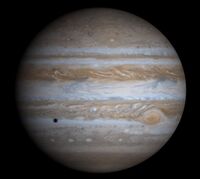
The planet Jupiter (P5), photographed by the Cassini spacecraft on its way to Saturn (P6)
Mid-Jupiter (M-Class II, symbol Jb, slogan: high-mass planet), also known coincidally as jovian planet, is a classification of planet with mass ranging from 0.5 to 2 Jupiter masses or 158.916 to 635.664 Earth masses. Mid-Jupiters are Template:Wpd with no solid surface.
Characteristics
Mid-Jupiters are Template:Wpd with no solid surface, but there is a rocky core surrounded by liquid hydrogen-helium mixtures in upper mantles and liquid metallic H-He in lower mantles. Those planets have banded clouds with several featured storms powered by interiors or sunlight depending on the planet's distance from the star. Mid-Jupiters have radii ranging from 0.8 RJ to 1.4 RJ. Hot Jupiters are larger, up to 2 RJ, caused by intense heating from nearby stars causing thermal expansion.
Abundance
There are an estimated 69 billion mid-Jupiters in Template:Wpd alone, making it the second least abundant mass class of planet after super-Jupiter. This corresponds that 84‰ of all 820 billion planets in our galaxy are mid-Jupiters.
Known mid-Jupiters
Jupiter (Sol f, P5, 1.00 MJ) and over 280 known exoplanets as of February 2014 are mid-Jupiters. Notable examples of extrasolar mid-Jupiters are Bellerophon (51 Pegasi b, P13, 1.52 MJ), which was the first exoplanet discovered aside from pulsar planets on October 6, 1995, Osiris (HD 209458 b, P30, 0.68 MJ), Teumesia (HD 189733 b, P161, 1.13 MJ), and Tapio (PSR J1719-1438 b, P576, 1.02 MJ), which is an ultra-dense diamond planet. However Tapio was a white dwarf in the past but lost more than 99.9% of its original mass because of the proximity to its parent pulsar causing mass transfer.
| ||||||||||||||